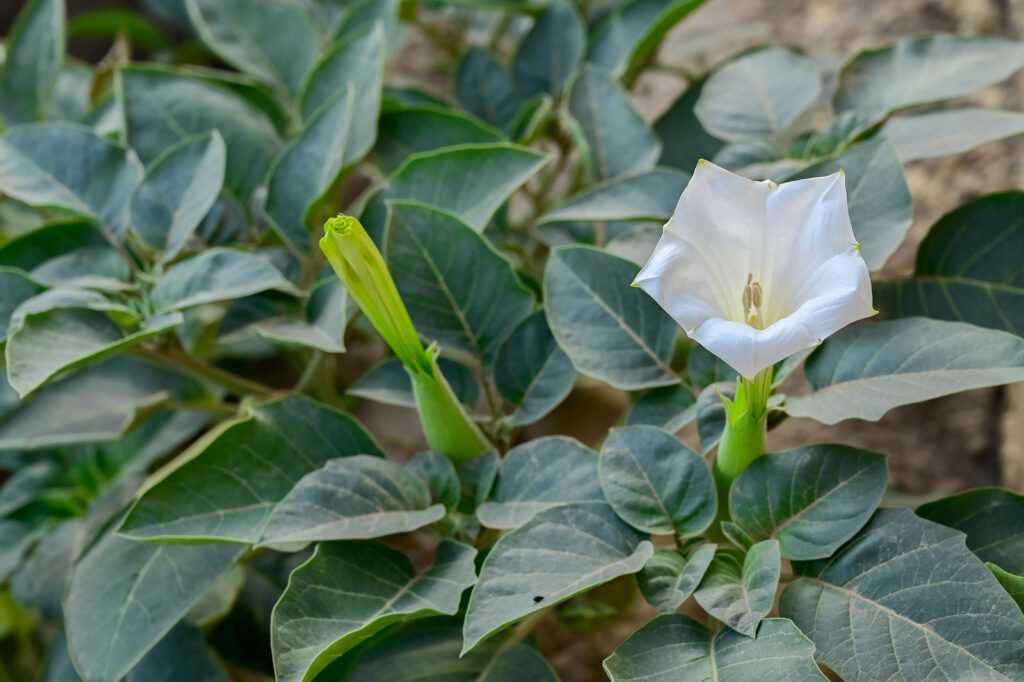Datura–often called angel’s trumpet– is an annual or short-lived perennial that bears stiking trumpet-shaped flower. Flowers are commonly white and up to 8 inches (20cm) long and nearly just as wide. Flowers appear in mid to late summer; they are followed by large spiny fruits which are poisonous.
Datura’s fragrant flowers appear on trailing stems surrouned by elliptical or oval grayish green leaves. Datura can be trained up on supports or a trellis.
Once species Datura wrightii is grown for its fragrant flowers. Another species D. stramonium is commonly called jimson weed; it is a common North American weed, especially in dry, warm regions.
Datura flowers look very much like the flower of Brugmansia, also commonly called angel’s trumpet. Brugmansia differs from Datura in that it is woody; the Brugmansia genus lncludes shrubs and trees.
Datura is a genus of eight species of annuals and short-lived perennials native to southern North America.
All parts of Datura plants are poisonous.
Get to know Datura
- Plant type: Annual, short-lived perennial
- Growing zones and range: Zones 8-10
- Hardiness: Killed by frost
- Height and width: 3 feet (90cm) tall and 2 feet (60cm) wide
- Foliage: Undivided leaves wtih smooth or wavy-toothed edges; foliage has an unpleasant scent when bruised
- Flowers: Showy, trumpet-shaped flowers that point upward; flowers are fragrant
- Bloom time: Mid to late summer
- Uses: Pernnial or shrub border; large containers
- Common name: Thorn apple, angel’s trumpet
- Botanical name: Datura
- Family name: Solanaceae
- Origin: Tropical, subtropical, warm temperate regions in the Americas

Where to plant Datura
- Grow Datura in full sun.
- Plant Datura in average, well-drained soil.
- Plant Datura where the nighttime fragrance can be enjoyed.
When to plant Datura
- Sow Datura seeds 8 to 10 weeks before the last spring frost.
- Set container-grown plants in the garden after the last frost in spring.
Planting and spacing Datura
- Space Datura 2 feet (60cm) apart.
How to water and feed Datura
- Water Datura to keep the soil evenly moist; established plants can tolerate dry soil.
- It is not necessary to feed Datura.
Datura care
- Datura can sprawl. For upward growth, give plants stake teepees.
- Transplant Datura with care; the roots do not like being disturbed.
- Deadhead after flowering to prevent poisonous fruit from forming.
Datura pests and diseases
- Aphids can attack Datura.
Datura propagation
- Sow seed either outside when all danger or frost is past, or indoors in early spring.
- Datura seeds germinate in about 14 days at 60°F (16°C).
- Sow seeds directly in the garden where the soil does not get cold in winter.
Datura varieties to grow
- Datura inoxia, angel’s trumpet. Fragrant pink or lavender flowers with green veins; broad oval gray green leaves; grows to 3 feet tall.
- D. stramonium, thorn apple, jimsonweed. Erect white or purplish flowers to 4 inches long; elliptical or oval grayish green leaves; grows to 3 feet tall.
- D. wrightii, angel’s trumpet. Annual grown for its flowers; grows 3 to 5 feet, usually trailing; felted, wavy-toothed leaves; showy 5 to 6 inch long, 6 to 8 inches wide white trumpet flowers tinged with purple or pale lilac; each flower lasts one night. Cultivars include ‘Cornucopaea’ has double purple trumpets and purple leaves; ‘Evening Fragrance’ bears fragrant white flowers touched with pale lavender.



